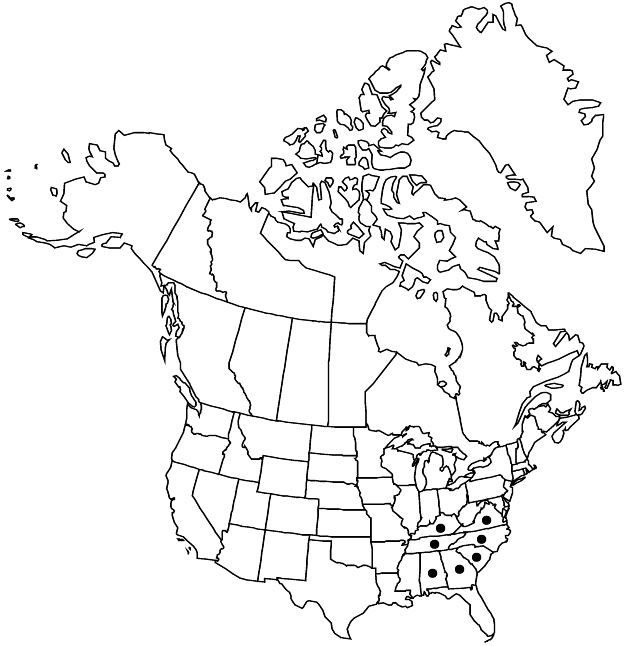Rhododendron cumberlandense
Rhodora 43: 33. 1941 ,.
Shrubs, to 2 m, usually rhizomatous. Stems: bark smooth to vertically furrowed, shredding; twigs very sparsely to conspicuously multicellular eglandular-hairy (hairs unbranched), otherwise glabrous or densely unicellular-hairy. Leaves deciduous; petiole usually multicellular eglandular-hairy and usually unicellular-hairy; blade ovate to obovate, 3.1–8.1 × 1.3–3.5 cm, thin, membranous to chartaceous, margins entire, plane, unicellular-ciliate, apex acute to obtuse, often mucronate, abaxial surface glabrous or very sparsely eglandular-hairy, (usually glaucous), adaxial surface glabrous or sparsely scattered eglandular-hairy. Floral bud-scales glabrous abaxially, margins usually ciliate distally, glandular proximally. Inflorescences 3–7-flowered; bracts similar to bud-scales. Pedicels 4–9 mm, eglandular-hairy, rarely stipitate-glandular-hairy (then sepals eglandular), otherwise sparsely to densely unicellular-hairy. Flowers opening after leaves have expanded, erect to horizontal, acrid-scented; calyx lobes 1–3 mm, scattered, long-stipitate, usually eglandular-hairy, and unicellular-hairy, margins extremely long stipitate-eglandular-hairy (rarely long stipitate-glandular-hairy, then pedicels eglandular); corolla red, with indistinct blotch or darker-colored region on upper lobe, funnelform, 27–45 mm, scattered stipitate-glandular-hairy, otherwise ± densely unicellular-hairy on outer surface, petals connate, lobes 14–30 mm, tube abruptly expanding into lobes, 14–24 mm (equaling or much longer than lobes); stamens 5, much exserted, ± unequal, 42–62 mm. Capsules borne on erect pedicels, 12–28 × 5–8 mm, sparsely to densely long stipitate-eglandular-hairy and sparsely to moderately unicellular-hairy. Seeds without distinct tails, flattened portion of testa may well developed at each end; testa expanded, dorsiventrally flattened, ± loose. 2n = 26.
Phenology: Flowering summer.
Habitat: Ridge tops, mixed deciduous forests
Elevation: 300-1800 m
Distribution

Ala., Ga., Ky., N.C., S.C., Tenn., Va.
Discussion
Rhododendron cumberlandense has a geographic distribution that is concentrated in the Cumberland Plateau and Mountains region with some populations in the southern Blue Ridge. It is most closely related to R. calendulaceum and can be distinguished from the latter by its flowering well after the leaves have expanded, eglandular pedicel and sepal margins, and usually abaxially conspicuously glaucous leaves. Hybrids are known with R. arborescens and R. viscosum. Rhododendron bakeri (Lemmon) Skinner very likely represents a hybrid between R. flammeum and R. canescens, although it has often been synonymized with R. cumberlandense (see K. A. Kron 1993).
Selected References
None.
Lower Taxa
No values specified.